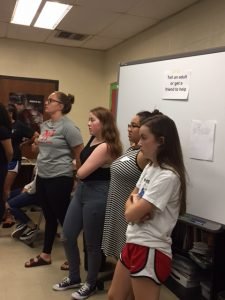
You know when you learn about something for the first time, or have just been talking about something, and then you start to notice it everywhere? It feels like it didn’t exist before, but now that you know what it is, you see it everywhere- whether it is a type of bird, a specialty food, a make of a car, or a form of relationship abuse. Now we can identify it. We can name it. We have the power to see it, all because we have suddenly become aware of this “new” thing.
Before starting at REACH this fall, I did not know that February was Teen Dating Violence Awareness Month (TDVAM). I knew that teen dating violence was a problem but I did not know that people had designated an entire month of awareness. I had not noticed how much work was already being done.
Some people have been responding to the #MeToo movement with a similar lack of awareness. Now that we are noticing- that we have been given the language for it- it is everywhere. But just as flamingos did not start existing when we learned their name, sexual harassment and assault (forms of relationship abuse) have existed as long as people have wanted power over other individuals (read: always).
I had another moment of realization a couple of years ago. I was in graduate school doing research for my thesis and came across a comic called Neela and Chris: Broken Love. In “Neela and Chris” an adult (aunt) reflectively describes an abusive relationship she had while in high school to her young niece. While reading the comic I noticed that many elements of this fictional story resonated with some of my own experiences. The comic screamed “me too” in my face. I had to catch my breath. So that’s what that was? That’s why I felt that way? Got it. So now that I’ve named it, what do I do now?
With the #MeToo movement circulating across every form of media we may feel overwhelmed, just like I did when I first read that comic. But the thing that helps me do this work with REACH is the understanding that in order to face any problem, we need to name it first. This is why we are primed for TDVAM. The conversation has already been started for us. We have named the issue, and we have work to do.

For in its most simple interpretation, TDVAM is about raising awareness. As the Youth Education Specialist on the prevention team, my goal is to teach social skills, engage in critical dialogue, and raise awareness of what healthy and unhealthy relationships are in order to prevent relationship abuse before it occurs, or at least meet situations at their nascent stages. I go into schools and communities to help youth develop the ability to notice and name. Then we build the skills needed to address the issues. Only once we have become aware of something are we able to ask ourselves: can I help my friend? Can I reach out for help with my own relationship? Do I like this? Do I want this? Am I being respected as a whole individual?
This TDVAM it is crucial to ask these questions and to continue this conversation between friends and colleagues, with our children and families, and within ourselves. We know that now is the time to be aware of teen dating violence. So now what?
 I encourage you to start a conversation with the young people in your lives. It’s never too early or too late to talk about consent and healthy relationships. REACH has great tips on how to talk to kids at different ages about these issues. This month and in the months to come, I encourage us all to recognize what we can do to educate others and ourselves. At times this may feel triggering, so make sure to practice many forms of self-care. As we focus on raising awareness, continue to name it. Continue to help others name it. And continue to ask: now what?
I encourage you to start a conversation with the young people in your lives. It’s never too early or too late to talk about consent and healthy relationships. REACH has great tips on how to talk to kids at different ages about these issues. This month and in the months to come, I encourage us all to recognize what we can do to educate others and ourselves. At times this may feel triggering, so make sure to practice many forms of self-care. As we focus on raising awareness, continue to name it. Continue to help others name it. And continue to ask: now what?





